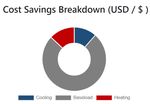BETTER: A Tool to Identify Cost-Saving Energy and Emissions Reductions in Buildings and Portfolios
←
→
Page content transcription
If your browser does not render page correctly, please read the page content below
BETTER: A Tool to Identify
Cost-Saving Energy and
Emissions Reductions in
Buildings and Portfolios
The Building Efficiency Targeting Tool for Energy
Retrofits (BETTER) delivers actionable insights to
improve energy, emissions, and financial performance in
buildings and portfolios without requiring site visits and
complex modeling. The tool identifies immediate, cost-
saving operational measures and technology upgrades
to reduce energy and emissions while prioritizing
“The ability of the tool to go
facilities for more in-depth audits and analysis.
beyond benchmarking by
offering energy efficiency
How it Works measure recommendations
is extremely valuable,
BETTER utilizes an open-source, data-driven analytical
engine and user-friendly web interface to automatically
particularly at times when
analyze a building’s monthly energy usage in response on-site assessments are
to weather conditions. With minimal data inputs, either impractical or not
the tool benchmarks a building’s electric and fossil feasible.”
energy usage against peers; quantifies energy, cost
and greenhouse gas (GHG) reduction potentials at
the building and portfolio levels; and recommends
energy efficiency measures to decarbonize and electrify
buildings and portfolios. Eric Noller, Principal
Energy Resources Integration LLC
San Francisco, CA
Who is Using BETTER?
BETTER is used by federal, state, and municipal
government agencies, including the National
Aeronautics and Space Administration (NASA) –
Goddard Space Flight Center and the Department of
Energy and Environment in the District of Columbia;
school districts; energy service companies, including
Johnson Controls; multinational corporations; investors
and lenders, like Citi; and non-profit organizations, such
as World Resources Institute (WRI).
Visit: better.lbl.gov
Vist the open-source analytical engine:
github.com/LBNL-ETA/BETTER_analytical_engineHow to Use BETTER
BETTER Inputs BETTER Output Reports
Data inputs are minimal: Single Building: Portfolio:
∙ Building ID or name ∙ Annual energy, cost, and ∙ Annual energy, cost, and
∙ Location emissions reduction potential emissions reduction potential
∙ Gross floor area (excluding ∙ Energy efficiency ∙ Top 5 energy efficiency
parking) recommendations and recommendations
implementation guidance ∙ Electricity and fossil energy
∙ Primary building space type
(i.e., ≥ 50% of the gross ∙ Annual utility cost and savings use intensity (EUI) and cost
floor area) breakdowns by load type savings comparisons by
∙ Monthly electric and fossil building
∙ 12 consecutive months of
energy use and costs for all energy use trends ∙ Ability to sort, rank, and
fuels used in the building ∙ Electricity and fossil fuel change- prioritize buildings for
point models and benchmarks upgrades
What Do These Reports Look Like?
Portfolio Analysis
∙ Compare and rank buildings across
a portfolio according to annual
electricity and fossil EUI and annual
cost savings potential.
∙ Buildings with high cost savings
potential are good candidates for
audits and further analysis.
∙ Buildings with high fossil EUI represent
opportunities for electrification and
decarbonization.
Utility Cost & Savings
Breakdowns
∙ Assess the breakdown of annual utility
costs and potential savings by load type
(e.g., cooling, baseload, and heating).
∙ Prioritize the highest cost-saving energy
efficiency improvements in a building.
Change-Point Models
& Benchmarking
∙ Investigate electricity and fossil
fuel change-point models.
∙ See how model coefficients
benchmark against peers to
further evaluate energy savings.BETTER Complements Other Tools
BETTER can be used in combination with the U.S. Environmental Protection Agency ENERGY STAR®
PortfolioManager® and the U.S. Department of Energy (DOE) Building Energy Asset Score to conduct multilayered
analysis on buildings to deliver both superior structural performance and operational energy performance.
Currently, BETTER can input data from ENERGY STAR® PortfolioManager®, and a BuildingSync® file read/write
capability is being added to facilitate data and analytics transfer between BETTER and Asset Score, Audit Template,
and the Standard Energy Efficiency Data (SEED) PlatformTM.
HIGH-LEVEL ANALYSIS MID-LEVEL ANALYSIS DEEP-LEVEL ANALYSIS
Rate actual operational Assess physical and
Quantify actual
energy performance structural energy
operational energy, cost,
against peers performance using
and emissions
whole-building simulation
reduction potential
Earn the
ENERGY STAR® plaque Select cost-effective
Identify efficiency
for superior operational physical and structural
measures to
energy performance improvements for
improve operational
implementation
energy performance
Target buildings for
detailed analysis of
potential structural
improvements using
Asset Score
To get started, visit better.lbl.gov or contact:
Harry Bergmann Carolyn Szum Marc LaFrance
U.S. DOE Lawrence Berkeley National Laboratory U.S. DOE
harry.bergmann@ee.doe.gov ccszum@lbl.gov marc.lafrance@ee.doe.gov
BETTER is made possible by support from the U.S. DOE Office of Energy Efficiency and Renewable Energy (EERE) Building Technologies
Office (BTO). It is being developed under Cooperative Research and Development Agreement (CRADA) No. FP00007338 between the
Regents of the University of California Ernest Orlando Lawrence Berkeley National Laboratory, under its U.S. DOE Contract No. DE-AC02-
05CH11231, and Johnson Controls, with assistance from ICF.You can also read























































